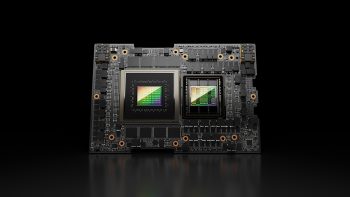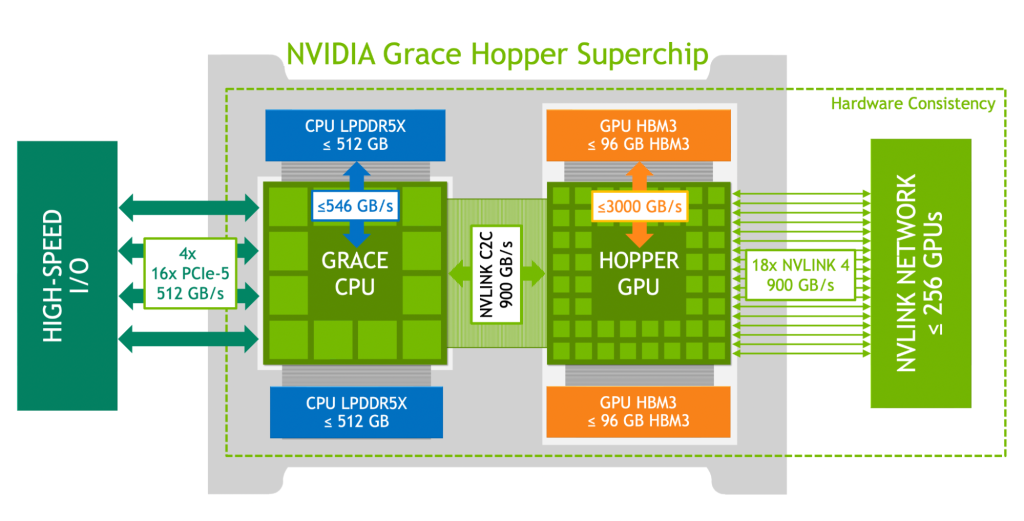
Driving a fundamental shift in the high-performance computing industry toward Artificial Intelligence (AI)-powered systems, NVIDIA has announced nine new supercomputers worldwide are using NVIDIA Grace Hopper™ Superchips to speed scientific research and discovery. Combined, the systems deliver 200 exaflops, or 200 quintillion calculations per second, of energy-efficient AI processing power.
New NVIDIA Grace Hopper-based supercomputers coming online include:
- EXA1-HE, in France, from CEA and Eviden
- Helios at Academic Computer Centre Cyfronet, in Poland, from Hewlett Packard Enterprise (HPE)
- Alps at the Swiss National Supercomputing Centre, from HPE
- JUPITER at the Jülich Supercomputing Centre, in Germany
- DeltaAI at the National Center for Supercomputing Applications at the University of Illinois Urbana-Champaign
- Miyabi at Japan’s Joint Center for Advanced High Performance Computing — established between the Center for Computational Sciences at the University of Tsukuba and the Information Technology Center at the University of Tokyo.
CEA, the French Alternative Energies and Atomic Energy Commission, and Eviden, an Atos Group company, in April announced the delivery of the EXA1-HE supercomputer, based on Eviden’s BullSequana XH3000 technology. The BullSequana XH3000 architecture offers a new, patented warm-water cooling system, while the EXA1-HE is equipped with 477 compute nodes based on Grace Hopper.
“AI is accelerating research into climate change, speeding drug discovery, and leading to breakthroughs in dozens of other fields,” said Ian Buck, vice president of hyperscale and HPC at NVIDIA. “NVIDIA Grace Hopper-powered systems are becoming an essential part of HPC for their ability to transform industries while driving better energy efficiency.”
In addition, Isambard-AI and Isambard 3 from the University of Bristol in the U.K. and systems at the Los Alamos National Laboratory and the Texas Advanced Computing Center in the U.S. join a growing wave of NVIDIA Arm-based supercomputers using Grace CPU Superchips and the Grace Hopper platform.
Sovereign AI
The drive to construct new, more efficient, AI-based supercomputers is accelerating as countries around the world recognize the strategic and cultural importance of sovereign AI—investing in domestically owned and hosted data, infrastructure, and workforces to foster innovation.
Bringing together the Arm-based NVIDIA Grace CPU and NVIDIA Hopper™ GPU architectures using NVIDIA NVLink®-C2C interconnect technology, GH200 serves as the engine behind scientific supercomputing centers across the globe. Many centres are planning to go from system installation to real science in months instead of years.
Isambard-AI phase one consists of an HPE Cray EX2500 supercomputer with 168 NVIDIA GH200 Superchips, making it one of the most efficient supercomputers ever built. When the remaining 5,280 NVIDIA Grace Hopper Superchips arrive at the University of Bristol’s National Composites Centre this summer, it will increase performance by about 32x.
“Isambard-AI positions the U.K. as a global leader in AI, and will help foster open science innovation both domestically and internationally,” said Simon McIntosh-Smith, professor of high-performance computing at the University of Bristol. “Working with NVIDIA, we delivered phase one of the project in record time, and when completed this summer will see a massive jump in performance to advance data analytics, drug discovery, climate research and many more areas.”
Accelerating Scientific Discovery with NVIDIA Grace Hopper
NVIDIA’s accelerated computing platform comprises NVIDIA Hopper architecture-based GPUs, NVIDIA Grace CPU Superchips, NVIDIA Grace Hopper Superchips, NVIDIA Quantum-2 InfiniBand networking and a full suite of NVIDIA AI and HPC software.

NVIDIA Grace Hopper architecture
 (0)
(0) (0)
(0)Archive
- October 2024(44)
- September 2024(94)
- August 2024(100)
- July 2024(99)
- June 2024(126)
- May 2024(155)
- April 2024(123)
- March 2024(112)
- February 2024(109)
- January 2024(95)
- December 2023(56)
- November 2023(86)
- October 2023(97)
- September 2023(89)
- August 2023(101)
- July 2023(104)
- June 2023(113)
- May 2023(103)
- April 2023(93)
- March 2023(129)
- February 2023(77)
- January 2023(91)
- December 2022(90)
- November 2022(125)
- October 2022(117)
- September 2022(137)
- August 2022(119)
- July 2022(99)
- June 2022(128)
- May 2022(112)
- April 2022(108)
- March 2022(121)
- February 2022(93)
- January 2022(110)
- December 2021(92)
- November 2021(107)
- October 2021(101)
- September 2021(81)
- August 2021(74)
- July 2021(78)
- June 2021(92)
- May 2021(67)
- April 2021(79)
- March 2021(79)
- February 2021(58)
- January 2021(55)
- December 2020(56)
- November 2020(59)
- October 2020(78)
- September 2020(72)
- August 2020(64)
- July 2020(71)
- June 2020(74)
- May 2020(50)
- April 2020(71)
- March 2020(71)
- February 2020(58)
- January 2020(62)
- December 2019(57)
- November 2019(64)
- October 2019(25)
- September 2019(24)
- August 2019(14)
- July 2019(23)
- June 2019(54)
- May 2019(82)
- April 2019(76)
- March 2019(71)
- February 2019(67)
- January 2019(75)
- December 2018(44)
- November 2018(47)
- October 2018(74)
- September 2018(54)
- August 2018(61)
- July 2018(72)
- June 2018(62)
- May 2018(62)
- April 2018(73)
- March 2018(76)
- February 2018(8)
- January 2018(7)
- December 2017(6)
- November 2017(8)
- October 2017(3)
- September 2017(4)
- August 2017(4)
- July 2017(2)
- June 2017(5)
- May 2017(6)
- April 2017(11)
- March 2017(8)
- February 2017(16)
- January 2017(10)
- December 2016(12)
- November 2016(20)
- October 2016(7)
- September 2016(102)
- August 2016(168)
- July 2016(141)
- June 2016(149)
- May 2016(117)
- April 2016(59)
- March 2016(85)
- February 2016(153)
- December 2015(150)
